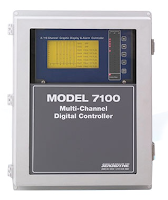 |
| Toxic / Flammable Gas Detection (courtesy of Sensidyne) |
Due to the variation in facilities and associated industrial purposes, the applicability and customization of fixed point monitors must be adaptable. The gases typically monitored by fixed point systems are industrial staples. Natural gas (methane) and hydrogen are inherently dangerous to work with due to both their combustible nature and flammability. Carbon monoxide, hydrogen sulfide, and chlorine are especially dangerous to those who work in and around facilities where they are used or produced, while otherwise harmless gases such as nitrogen can cause oxygen displacement leading to asphyxiation. Around-the-clock is the only way to monitor and mitigate the potential impact of such volatile substances; thanks to automation, the ability to be constantly vigilant of threats related to gases is possible.
 |
| Hazardous Gas Sensor (courtesy of Sensidyne) |
Sensing and evaluating these types of gases is a complex process, yet one which also showcases the powers of the associated technology. International certification standards like ATEX (derived from a French regulation acronym) and SIL (the safety integrity level) allow designers of gas detectors to match their products with the necessary parameters to ensure safe working environments. For example, one manufacturer's electrochemical gas sensor operates based on a principle involving two electrodes; the first electrode senses the toxic gas, and then the second electrode receives protons generated by the sensing electrode through an ion conductor. Output current which flows to an external circuit is proportional to the concentration of gas, therefore the current generated is measurable as an indicator of gas levels. Despite the fact that these sensors are primarily used in industry, there is also the potential for domestic applicability, automotive process control, and air quality control, among other uses. The different technological and practical applications of fixed point gas monitors allow for industry professionals to safely and capably navigate working environmental hazards for personnel and process protection.
For more information on industrial gas detection and monitoring, visit Ives Equipment at http://www.ivesequipment.com or call (877) 768-1600.